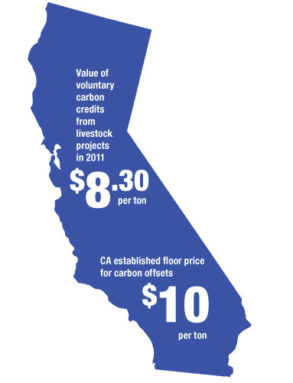California’s Cap-And-Trade Regulation took effect on January 1 this year and marks a significant shift in how carbon credits from dairy digester projects built throughout the U.S. will be generated and sold.
We are now moving from selling dairy digester credits in a voluntary U.S. carbon market where business entities or organizations purchase carbon credits for corporate sustainability initiatives and general goodwill to a compliance market where large qualified emitters in California such as utilities, refiners and cement producers must meet their emissions reduction obligations or face financial penalties.
Beginning next year and running through 2020, qualifying emitters of greenhouse gases in California have enforceable compliance obligations that they must meet. The first auction of compliance allowances will be held this November.
Emitters that cannot fulfill their capped limit of greenhouse gas emissions through their allotted purchase of allowance permits have the option of purchasing allowances from other California emitters, purchasing offsets (carbon credits) generated by non-regulated entities located in the U.S. or paying the financial penalties.
Credits from livestock projects sold into the voluntary carbon market sold for an average of $8.30 last year according to an annual survey released by Ecosystems Marketplace. A successful launch of the California Cap-and-Trade program, which will be administered by the California Air Resources Board (ARB), will see the market for compliance-grade carbon credits expand as emitters look to use offsets to comply with their obligations.
While offsets/carbon credits will always be worth less than allowances in the compliance market (there is more risk associated with the generation and use of offsets), the established floor price of $10 per ton for allowances will provide a benchmark for future offset pricing.
The ultimate value of the ARB carbon offsets will be determined through market conditions including the demand and supply of allowances and offsets. Currently, offsets which are eligible to be used in the California compliance market command a higher price than those sold into the voluntary market.
For this reason, we expect the carbon development industry to transfer qualifying dairy digester projects from voluntary standards to the compliance ARB Protocol.
The components of the California Cap-and-Trade program have taken many years to prepare; however, the endgame is in sight. The ARB is currently in the process of accrediting verifiers (project auditors) and approving registries where ARB offsets can be issued and transacted.
Dairy digester projects that are already registered with an existing eligible offset program will have the option of going through a second approval process to create Early Action Offset Credits or can re-list their projects under the ARB's Livestock Protocol.
A remaining significant hurdle to the implementation of the ARB offset program is a court case that is challenging the use of offsets within the California Cap-and-Trade program. The case is expected to be heard toward the end of this year.
The ARB has made a strong case to justify the use of offsets within the Cap-and-Trade program; a court ruling that does not support the offsets program designed by the ARB would have significant impacts for qualified emitters and sellers of offsets.
How to get your digester project into the Compliance Offset Program
Dairy digester projects that will be eligible for conversion into the ARB program include new digester projects built in the U.S. after 2006 or any digester projects currently listed under eligible early-action offset programs (such as the voluntary CAR program) that were built in the U.S. after January 1, 2005.
Older digester projects that were built before 2005 and that are not currently registered in recognized voluntary carbon programs will not be eligible for the ARB Livestock offset program.
Digester projects that have been listed in the voluntary CAR registry but that have not registered credits through the CAR program should think about moving their digester projects into the ARB program. The same is true for any digester projects that were listed in other qualifying voluntary carbon credit programs.
Operating in a compliance program means greater regulatory oversight and scrutiny and less flexibility. For example, the protocols used by ARB have been approved through a long regulatory process and cannot be easily changed to take into account situations where equipment has malfunctioned and data is missing.
As a result, digester projects that move to the ARB Livestock Protocol will need to be very focused on collecting and managing all the data necessary to demonstrate emissions reductions have occurred. Project operators will also need to make sure they are aware of the changing regulatory landscape in the early years of the new program.
Working with a carbon project developer focused on the generation and maximization of offsets provides advantages to digester projects seeking to generate carbon revenue. A company that focuses on the production and sale of credits can stay on top of regulatory developments, help ensure that rigorous ARB monitoring requirements are met and that any problem is speedily resolved or mitigated.
In summary, the California Cap-and-Trade compliance market is projected to be in full swing at the end of this year, with the market for carbon credits outpacing the historic voluntary market. Existing and new digester projects have an opportunity to participate in this program and generate valuable revenue.
The more heavily regulated nature of the market will require a strong focus on monitoring and reporting of project data and the ongoing development of regulations. An ability to navigate the credit generation process from third- party auditor onto an independent registry and final vetting by the ARB will be required.







